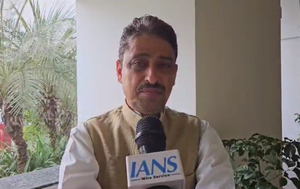Beijing: China on Thursday successfully launched the country’s first space telescope in search for signals of dark matter, an invisible material that makes up most of the universe’s mass. The Dark Matter Particle Explorer (DAMPE) Satellite, which has been given the moniker “Wukong” after the Monkey King from the Chinese classical fiction “Journey to the West, “was launched on a Long March 2-D rocket from Jiuquan Satellite Launch Centre. It will enter a sun-synchronous orbit at a height of 500 km to observe the direction, energy and electric charge of high-energy particles in space. The satellite is designed to undertake a three-year space mission, but scientists hope it could last five, state-run Xinhua news agency reported.
They also hope the 1.9-tonne desk-sized satellite could help shine more light on the hypothetical mass during that short period. Dark matter, which does not emit or reflect enough electromagnetic radiation to be observed directly, is one of the huge mysteries of modern science. Theorised by scientists who could not understand missing mass and strangely bent light in faraway galaxies, dark matter has become widely accepted in the physics community even though its existence has never been concretely proven. Scientists now believe that only around five per cent of the total mass-energy of the known universe is made up of ordinary matter—protons, neutrons, electrons— whereas dark matter and dark energy make up the rest.
“Exploration of dark matter could, therefore, give us a clearer idea about the past and future of galaxies and the universe, and will be revolutionary for the world of physics and space science,” Chang Jin, chief scientist on the project said. China also runs an underground dark matter lab in the southwest province of Sichuan, some 2,400 metres under the earth’s surface. DAMPE will support research using the third method, scientists are hoping the findings will help clarify previous observation results and lift the “invisible cloak” of dark matter. “This is like tracking down the ‘son’ of dark matter—if you cannot find the father, you go to the son and you could learn about at least some properties of his father,” Chang said.
Wukong will scan space in all directions in the first two years and focus on sections where dark matter is most likely to be observed afterward. Chang said Wukong has the widest observation spectrum and highest energy resolution of any dark-matter probe in the world. The new satellite’s observation spectrum is approximately nine times wider than the Alpha Magnetic Spectrometer onboard the International Space Station, while its energy resolution is at least three times higher than its international peers, according to Chang.
Recent Random Post:
















